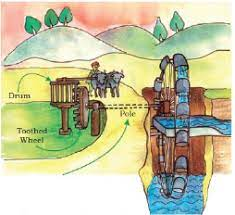WALL TELL STORIES
TLO
1. To know a historical monument to introduce children to the techniques, design, uses of
metals, and water arrangements of earlier times.
2. To identify the monuments
3. To know more about the forts in India.
Q1. Write about the Golconda Fort.
Ans. a) The walls of the Golconda fort are very thick.
b) The Golconda fort is very large.
c) It had a very heavy and big gate.
d) The outer wall of the fort has 87 bastions.
e) The fort was made in 1200AD.
f) The walls of the fort have beautiful carvings.
g) There is a large deep ditch along the thick walls of the fort.
h) After seeing Golconda Fort the children went to a museum in Hyderabad.
i) Qutubshahi sultans ruled Golconda from 1518 to 1687.
j) Moghul army fought for 8 months to capture the Golconda fort.
k) Golconda fort was captured by Aurangzeb in 1687AD.
Q3. What is History?
Ans. A subject in which we study about the past.
Q4. What were the Bastions in the fort?
Ans. A part of the wall comes out in a round shape. Bastions were made in the front wall to ensure the security of the fort. Big holes were made in Bastions to increase the viewing area and thus the soldiers peeping through it could have a better vigilance.
Q5. What is a Museum?
Ans. Museums collect and preserve our objects and materials of religious, cultural and historical value. They are a good source of entertainment. The museums promote our cultural heritage. Museums are a storehouse of old artefacts, sculptures, objects, history etc
Q8. How does Rehat work to uplift water from the well?
Ans. The bullocks move the drum, which in turn moves the toothed wheel. From this wheel garland wheel is connected through a rod. So as the toothed wheel moves, it rotates the garland wheel and thus water is lifted from the well.
Q9. What are the Four Basic Directions?
Ans. When we stand facing the rising Sun, we are looking towards the East.
Behind us is the West where the Sun sets.
On the left-hand side is the North.
The right-hand points to the South.
c) It had a very heavy and big gate.
d) The outer wall of the fort has 87 bastions.
e) The fort was made in 1200AD.
f) The walls of the fort have beautiful carvings.
g) There is a large deep ditch along the thick walls of the fort.
h) After seeing Golconda Fort the children went to a museum in Hyderabad.
i) Qutubshahi sultans ruled Golconda from 1518 to 1687.
j) Moghul army fought for 8 months to capture the Golconda fort.
k) Golconda fort was captured by Aurangzeb in 1687AD.
Q2. What was the Mashak?
Ans. Mashak is a leather bag used for carrying water.
Ans. Mashak is a leather bag used for carrying water.
Q3. What is History?
Ans. A subject in which we study about the past.
Q4. What were the Bastions in the fort?
Ans. A part of the wall comes out in a round shape. Bastions were made in the front wall to ensure the security of the fort. Big holes were made in Bastions to increase the viewing area and thus the soldiers peeping through it could have a better vigilance.
Q5. What is a Museum?
Ans. Museums collect and preserve our objects and materials of religious, cultural and historical value. They are a good source of entertainment. The museums promote our cultural heritage. Museums are a storehouse of old artefacts, sculptures, objects, history etc
Q6. What was a cannon, a big gun?
Ans. A cannon is a type of gun classified as artillery that launched a projectile using gunpowder In the past.
Q7. What are Nuclear bombs? Does it cause a lot of destruction?
Ans. A nuclear weapon is an explosive device that derives its destructive force from nuclear reactions, either fission or from a combination of fission and fusion reactions.
Ans. A cannon is a type of gun classified as artillery that launched a projectile using gunpowder In the past.
Q7. What are Nuclear bombs? Does it cause a lot of destruction?
Ans. A nuclear weapon is an explosive device that derives its destructive force from nuclear reactions, either fission or from a combination of fission and fusion reactions.
Q8. How does Rehat work to uplift water from the well?
Ans. The bullocks move the drum, which in turn moves the toothed wheel. From this wheel garland wheel is connected through a rod. So as the toothed wheel moves, it rotates the garland wheel and thus water is lifted from the well.
Q9. What are the Four Basic Directions?
Ans. When we stand facing the rising Sun, we are looking towards the East.
Behind us is the West where the Sun sets.
On the left-hand side is the North.
The right-hand points to the South.

(a) If you are peeping inside from Bodli Darwaza, in which direction from you id
Katora Hauz.
North
(b) If someone is entering from Banzara Darwaza, in which direction from her is
Katora Hauz.
South
(c) In which direction will you walk from Bala Hisar to reach Moti Mahal?
East
(d) How many gates can you see on the outer wall of the fort.
Eight/Nine
(e) Count how many palaces are there in the fort.
Five
(f) What arrangements for water can you see inside the fort?
Baoli and Hauz
(g) On the map, 1 cm distance is equal to 110 metres on the ground. Now tell
a. On the map, the distance between Bala Hisar and Fateh Darwaza is 8 cm.
On the ground, the distance between the two would be 880 metres.
b. How far is Makai Darwaza from Fateh Darwaza?
By road distance is 13 cm on map. So the actual distance would be 13 x 110
= 1430 metres.


























